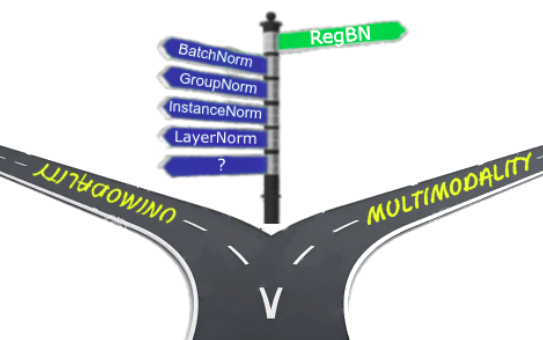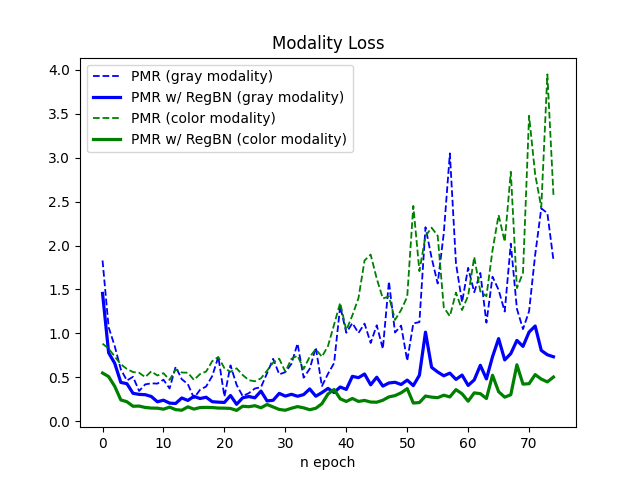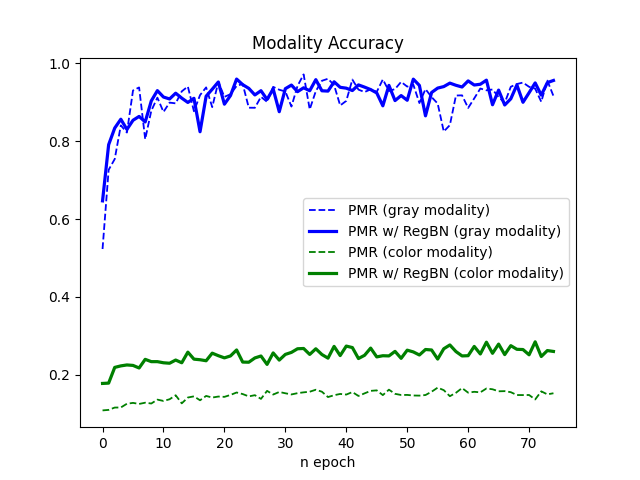This repository is the official implementation of RegBN: Batch Normalization of Multimodal Data with Regularization
A NeurIPS 2023 Paper (link)
Project (link)
RegBN facilitates the training of deep multimodal models while ensuring the prediction of reliable results with the following features:
- As a normalization module, RegBN can be integrated into multimodal models of any architecture such as multilayer perceptrons (MLPs), convolutional neural networks (CNNs), vision transformers (ViTs), and other architectures.
- It possesses the capability to be applied to a vast array of heterogeneous data types, encompassing text, tabular, audio, image, video, depth, and 3D MRI.
- It can be applied to any data/feature structure, removing dependency and confusing effects in your models!
Here, RegBN is employed in PMR as an example method, designed to address the "modality imbalance" issue and enhance the overall performance of Multimodal Learning (MML).
RegBN eliminates confounders and dependencies among multimodal data, enabling an MML model to converge more effectively!
RegBN code does not contain any extra modules and can be directly used in a standard torch model:
import torch
device = "cuda"
batchSize = 50
f = torch.rand([batchSize, 512])
g= torch.rand([batchSize, 64, 7, 7])
kwargs = {
'gpu': 0,
'f_num_channels': 512,
'g_num_channels': 64,
'f_layer_dim': [],
'g_layer_dim':[7, 7],
'normalize_input': True,
'normalize_output': True,
'affine': True,
'sigma_THR': 0.0,
'sigma_MIN': 0.0,
}
regbn_module = RegBN(**kwargs).to(device)
print(regbn_module)
# during training
epoch = 10
steps_per_epoch = 100 # number of batches, len(dataloader)
kwargs_train = {"is_training": True, 'n_epoch': epoch, 'steps_per_epoch': steps_per_epoch}
f_norm, g_norm = regbn_module(f, g, **kwargs_train)
print(f_norm.shape, g_norm.shape)
# during inference/eval
kwargs_infer = {"is_training": False}
f_norm, g_norm = regbn_module(f, g, **kwargs_infer)
print(f_norm.shape, g_norm.shape)Download the colored-MNIST from this link and then locate it at 'example_PMR/data/Mnist/colored_mnist/'
# w/o RegBN
cd example_PMR
python PMR.py --epochs 75 --learning_rate 0.001 --gpu 0 --train --batch_size 50 --optimizer Adam
# with RegBN
python PMR.py --epochs 75 --learning_rate 0.001 --gpu 0 --train --batch_size 50 --optimizer Adam --regbn- RegBN, as a multimodal normalization method, can be employed with various types of feature maps. Simply specify the size and feature dimensions in the input.
- RegBN can be employed as long as its inputs are not mutually independent.
- To optimize the performance of RegBN, it's advisable to choose a sensible number of channels. For instance, using feature maps with 512 channels for raw MNIST data of size [28, 28] may be considered impractical (Singularity thread!).
- Presently, RegBN is designed to work with a single GPU. This is due to the
torch.optim.LBFGSwhich do not support multiple GPUS right now. - RegBN, like other normalization techniques, can be used multiple times in neural networks. RegBN acts as an independence-promoting layer, so utilizing it multiple times in a row does not substantially alter the feature maps. For a pair of modalities, it is advised to employ RegBN once as a multimodal normalizer within various fusion paradigms.
- It is important to highlight that in the context of layer fusion (Figure 4c), where RegBN is employed multiple times, the input feature maps at each instance differ from one another.
RegBN functions by normalizing input X in relation to input Y, resulting in a normalized X with the same dimensions as the original input X. In fusion, inputs X and Y are combined to generate one or more outputs with distinct content and dimensions. RegBN can be used as a normalization method within the structure of any fusion or neural network. It would be intriguing to revisit the performance of fusion methods in the presence of RegBN.
If you use RegBN for your research, please cite the following work:
@inproceedings{ghahremani2023regbn,
title={RegBN: Batch Normalization of Multimodal Data with Regularization},
author={Ghahremani, Morteza and Wachinger, Christian},
booktitle={Thirty-seventh Conference on Neural Information Processing Systems (NeurIPS 2023)},
year={2023}
}The example PMR code is built upon PMR. Please refer to official webpage of the technique for more details.


